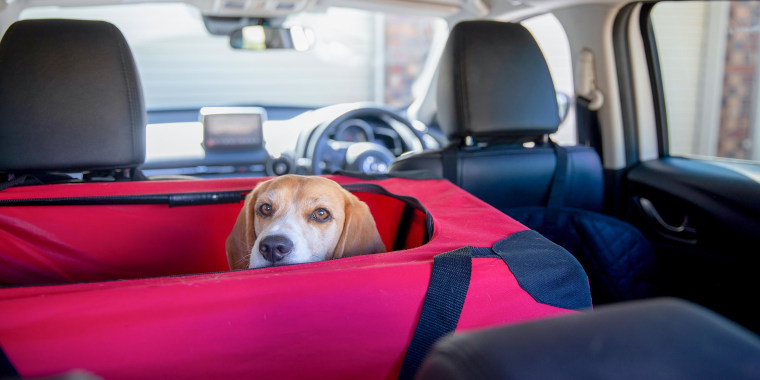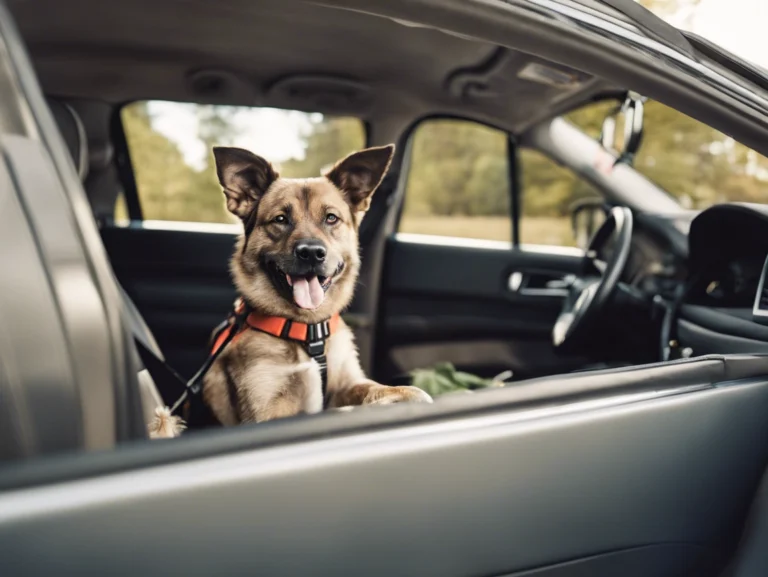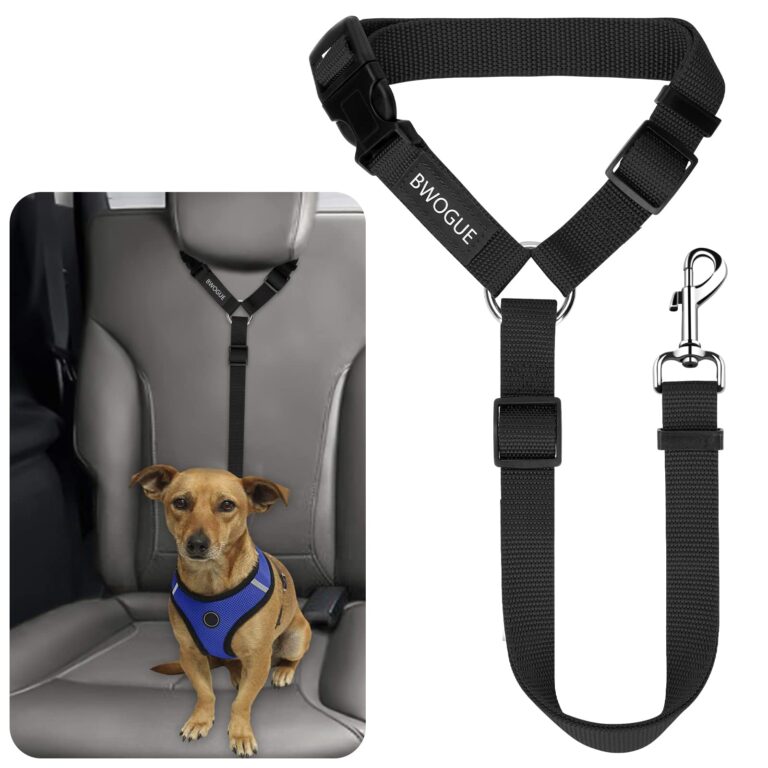What is the Best Type of Dog Seat Belt?: Ultimate Guide
The best type of dog seat belt is one that is crash-tested and adjustable for comfort and safety. It should also be easy to install and compatible with your vehicle.
Taking these factors into consideration will help you choose the most suitable dog seat belt for your furry friend. Protecting your dog during car rides is essential for their safety and your peace of mind. Dog seat belts provide a secure way to keep your pet restrained while traveling, preventing distractions and potential injuries.
When selecting a dog seat belt, prioritize features like durability, ease of use, and proper fit to ensure your dog’s protection on the road.
Introduction To Canine Car Safety
Ensuring the safety of your canine companion during car rides is of utmost importance. With an increasing number of pet parents recognizing the need for proper restraint systems, the market for canine car safety products has seen a significant surge. In this blog post, we will explore the importance of seat belts for dogs and the rise of pet travel accessories, shedding light on the best type of dog seat belt for your furry friend’s safety and comfort.
Why Seat Belts For Dogs Are Essential
When it comes to traveling in vehicles, dogs are just as susceptible to injuries as humans in the event of sudden stops or accidents. Without proper restraint, they can become projectiles, posing risks to themselves and the vehicle’s occupants. Dog seat belts help to keep your furry friend safe and secure, preventing them from moving about the vehicle and minimizing the chances of injury during unforeseen events.
The Rise Of Pet Travel Accessories
The surge in pet travel accessories reflects the growing awareness among pet owners about the importance of ensuring their pets’ safety during car journeys. From harnesses and seat belts to carriers and booster seats, the market now offers a wide array of products designed to keep pets secure and comfortable while on the road. As more pet parents prioritize their pets’ well-being, the demand for innovative and reliable canine car safety products continues to increase.

Credit: www.motor1.com
Types Of Dog Seat Belts
When it comes to selecting the best dog seat belt for your furry friend, there are several types available in the market. Here are the three most popular types of dog seat belts:
Harness Attachments
Harness attachments are the most common type of dog seat belts. These seat belts are designed to attach to your dog’s harness and keep them secure during car rides. Harness attachments come in different sizes and styles, so it’s important to choose one that fits your dog’s size and weight.
One of the benefits of using a harness attachment is that it distributes the force of a sudden stop or crash over your dog’s chest and back. This reduces the risk of injury to your dog’s neck and spine.
Zipline Seat Belts
Zipline seat belts are another popular type of dog seat belt. These seat belts allow your dog to move around more freely in the backseat while still being secured. Zipline seat belts consist of a long tether that attaches to the backseat of your car and a harness that your dog wears.
One of the benefits of using a zipline seat belt is that it provides your dog with more freedom of movement than a traditional harness attachment. However, it’s important to note that zipline seat belts are not suitable for dogs who like to chew or are easily tangled.
Clip-on Leads
Clip-on leads are a simple and affordable type of dog seat belt. These seat belts consist of a short lead that attaches to your dog’s collar and the seat belt buckle in your car.
One of the benefits of using a clip-on lead is that it’s easy to use and doesn’t require any special installation or equipment. However, it’s important to note that clip-on leads may not be as secure as harness attachments or zipline seat belts, especially in the event of a sudden stop or crash.
Choosing the best type of dog seat belt depends on your dog’s size, weight, and behavior. Harness attachments are the most common and safest type of dog seat belt, while zipline seat belts provide more freedom of movement. Clip-on leads are a simple and affordable option but may not be as secure as other types of seat belts.
Material And Durability
When it comes to choosing the best dog seat belt, the material and durability are crucial factors to consider. The type of material used in the seat belt and its overall durability directly impact the safety and comfort of your furry friend during car rides. Let’s explore the key aspects of material and durability when selecting a dog seat belt.
Nylon Vs. Metal: Pros And Cons
- Lightweight and flexible
- Provides comfort for the dog
- May not withstand heavy impact
- Durable and strong
- Offers enhanced safety and security
- Can be heavy and restrictive for the dog
Impact On Dog Comfort And Safety
The flexibility of nylon seat belts can provide a more comfortable experience for your dog during car rides. However, in the event of a strong impact, they may not offer the same level of protection as metal seat belts.
With its durability and strength, a metal seat belt can significantly enhance the safety of your dog in the car. However, it might be less comfortable for the dog due to its rigid nature.
Compatibility With Dog Sizes And Breeds
Finding the best type of dog seat belt depends on the compatibility with different dog sizes and breeds. It’s essential to choose one that fits securely and comfortably, providing safety during car rides. Keep your furry friend protected and enjoy stress-free travels.
Adjustability For Different Dogs
When it comes to choosing the best type of dog seat belt, one important factor to consider is the adjustability for different dogs. Dogs come in all shapes and sizes, and their comfort and safety are paramount when traveling in a vehicle. Look for a dog seat belt that offers adjustable straps or buckles, allowing you to customize the fit according to your dog’s size and body shape.
By opting for a seat belt with adjustable features, you can ensure that the belt fits snugly without being too tight or too loose. This is especially crucial for dogs that are still growing or those with unique body proportions. With the ability to adjust the seat belt, you can provide your furry friend with a secure and comfortable travel experience.
Breed-specific Considerations
Another important aspect to consider when choosing a dog seat belt is breed-specific considerations. Different dog breeds have varying sizes, body structures, and temperaments, which may influence the type of seat belt that works best for them. It’s essential to choose a seat belt that is compatible with your specific breed to ensure their safety and comfort.
For example, small dog breeds like Chihuahuas or Yorkies may require a different type of seat belt than larger breeds like Labradors or German Shepherds. Some seat belts may have specific design features or sizes that are better suited for certain breeds. Consider the needs and characteristics of your dog’s breed when making your selection.
In addition to size considerations, certain breeds may have unique temperaments or behaviors that can influence the type of seat belt you choose. For instance, anxious or highly energetic dogs may benefit from a seat belt that provides additional restraint or a calming effect, such as a harness with adjustable straps to keep them secure and relaxed during the journey.
Remember, each breed has its own requirements, so it’s important to research and choose a dog seat belt that caters to the specific needs of your four-legged companion.
Safety Standards And Certifications
Ensure your dog’s safety with a seat belt that meets rigorous safety standards and certifications. Look for options with crash-tested designs and durable materials to provide the best protection for your furry friend during car rides.
Certification Bodies For Pet Safety
Certification from reputable organizations like Center for Pet Safety (CPS) and International Crash Test Safety Certification (ICT) is crucial.What To Look For In Safety Testing
When choosing a dog seat belt, prioritize products tested in independent laboratories to ensure safety compliance.
Credit: www.goodhousekeeping.com
Ease Of Use And Installation
Dog seat belts should be easy to install and use. Look for a product that offers adjustable straps and can be secured to different types of car seats. The best type of dog seat belt is one that prioritizes safety and comfort for your furry friend.
When it comes to traveling with your furry friend, it’s important to keep them safe and secure. One of the best ways to do this is by using a dog seat belt. But with so many options available, it can be hard to know which one to choose. In this article, we’ll explore the best type of dog seat belt in terms of ease of use and installation.Step-by-step Guide To Installing A Dog Seat Belt
Installing a dog seat belt may seem daunting at first, but it’s actually a relatively easy process. Here’s a step-by-step guide to help you install your dog’s seat belt:- Start by choosing the right seat belt for your dog. Make sure it’s the right size and fits your car’s seat belt buckle.
- Next, attach the seat belt to your dog’s harness. It’s important to use a harness instead of a collar, as a collar can be dangerous in the event of an accident.
- Once the seat belt is attached to the harness, simply insert the other end into your car’s seat belt buckle.
- Adjust the length of the seat belt so that your dog can sit comfortably but can’t move around too much.
- Finally, double-check that everything is secure before hitting the road.
Quick Release Mechanisms
One feature to look for in a dog seat belt is a quick release mechanism. This allows you to easily and quickly release your dog from the seat belt in case of an emergency. Some quick release mechanisms use a button, while others use a buckle. Either way, it’s a good idea to have this feature in case you need to remove your dog from the car quickly. In conclusion, the best type of dog seat belt in terms of ease of use and installation is one that fits your dog properly and can be easily secured in your car. Look for features like a quick release mechanism to ensure your dog’s safety in the event of an emergency. And always remember to never leave your dog unattended in a car, even if they are wearing a seat belt.Comfort And Design Features
When it comes to choosing the best type of dog seat belt, comfort and design features are essential for ensuring your furry friend’s safety and well-being during car rides. Let’s explore the key considerations for comfort and design to help you make an informed decision.
Padding And Ergonomics
The padding and ergonomics of a dog seat belt are crucial for ensuring your pet’s comfort during car journeys. Look for seat belts with ample padding and ergonomic design to provide support and reduce pressure points, allowing your dog to relax while secured in the car.
Style Versus Functionality
When choosing a dog seat belt, it’s important to strike a balance between style and functionality. While a sleek design may be visually appealing, prioritize functionality to ensure the seat belt effectively restrains your dog and withstands sudden movements or impact.
:strip_icc()/best-dog-seat-belts-7969415-3ef761069ce64473bfa46aa8f2c7c193.jpg)
Credit: www.thesprucepets.com
Customer Reviews And Testimonials
Real User Experiences
When it comes to finding the best type of dog seat belt, real user experiences play a crucial role in making an informed decision. Reading through genuine customer reviews and testimonials can provide valuable insights into the performance, safety, and comfort of different dog seat belts. By learning from the experiences of other pet owners, you can make a confident choice for your furry friend.
Top-rated Dog Seat Belts On The Market
Discovering the top-rated dog seat belts on the market involves analyzing customer feedback and testimonials. By examining the features, durability, and overall satisfaction expressed by users, you can identify the leading options that prioritize safety and convenience for both you and your pet. Real user experiences can guide you towards selecting a dog seat belt that meets your specific needs and requirements.
Legal Requirements And Regulations
Ensure compliance with legal requirements and regulations when choosing the best type of dog seat belt. Look for options that meet safety standards and are approved by relevant authorities. Keeping your furry friend secure in the car is essential for their well-being and your peace of mind.
Legal Requirements and Regulations When it comes to traveling with your furry friend, it’s important to ensure their safety while riding in a vehicle. This is where dog seat belts come in. However, it’s not just a matter of choosing any dog seat belt. Legal requirements and regulations must be considered to ensure you are complying with the law and keeping your pet safe. State-Specific Dog Restraint Laws It’s crucial to know the dog restraint laws in your state before hitting the road with your furry companion. Some states require pets to be restrained in a vehicle while others do not. For instance, in California, it’s mandatory to restrain a dog with a seat belt or a crate while driving. Failing to do so can result in a fine of up to $150. In New Jersey, pets must be secured in a crate or a seat belt harness while driving. The fine for not complying with this law can be up to $1000. Therefore, it’s important to research the specific laws in your state to avoid any legal issues. International Travel with Pets If you plan to travel internationally with your pet, you must adhere to the regulations of the destination country. Each country has its own rules and regulations regarding pet travel, including the type of dog seat belt that is acceptable. For example, the United Kingdom requires dogs to be restrained with a seat belt or a crate while riding in a vehicle. The pet owner can be fined up to £500 if they fail to comply with this rule. Therefore, it’s important to research the regulations of the country you plan to visit to ensure a smooth and safe trip for you and your furry friend. In conclusion, legal requirements and regulations should be considered when choosing a dog seat belt for your furry friend. Understanding the state-specific dog restraint laws and the regulations of the country you plan to visit will ensure you comply with the law and keep your pet safe while traveling.Conclusion: Making The Right Choice
Choosing the best type of dog seat belt is crucial for your furry friend’s safety. With a variety of options available, it’s important to consider factors such as size, comfort, and ease of use to make the right choice. Keep your pup secure and protected during car rides with the perfect dog seat belt.
Balancing Safety, Comfort, And Cost
In selecting a dog seat belt, safety should always be the top priority. Comfort is crucial for your furry friend’s well-being during travel. Cost matters but should not compromise safety and comfort.Final Thoughts On Selecting The Best Dog Seat Belt
Consider safety ratings, adjustability, and ease of use when choosing a dog seat belt. Test the belt on your dog for comfort and fit. Invest in a quality product for your pet’s safety. – Safety comes first: Opt for crash-tested seat belts. – Comfort is key: Choose a belt that fits your dog well. – Value quality: Invest in a durable and reliable seat belt. Prioritize safety, comfort, and quality when selecting a dog seat belt. Choose wisely for your pet’s well-being on the road.Frequently Asked Questions
What Kind Of Dog Seat Belt Is Safest?
The safest dog seat belt is a crash-tested harness that securely attaches to the car’s seat belt system.
How To Choose A Seat Belt For A Dog?
To choose a seat belt for a dog, consider size, durability, comfort, safety features, and ease of use.
What Is The Best Dog Seat Belt For Long Car Rides?
For long car rides, the best dog seat belt is one that is sturdy, adjustable, and crash-tested for safety.
Are Dog Seat Belts A Good Idea?
Yes, dog seat belts are a good idea for pet safety in cars. They prevent distractions and protect pets in case of accidents.
Conclusion
Ultimately, the best dog seat belt is one that ensures your pet’s safety and comfort. Consider factors like size, material, and ease of use when choosing. Prioritize quality and reliability to provide your furry companion with the protection they deserve during car rides.
Make a well-informed decision for your beloved pet.
- Can I Get in a Taxi Without a Car Seat? - January 26, 2025
- Can I Get Chlamydia From a Toilet Seat? - January 26, 2025
- Can I Get an Uber With a Car Seat? - January 26, 2025






